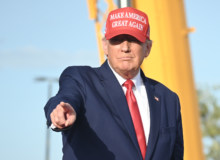Steele Dossier
[See update at bottom for another juicy link. – J.E.]
On 9 August, John Solomon reported at The Hill on his review of handwritten notes made by Justice Department official Bruce Ohr from Ohr’s December 2016 meeting with Glenn Simpson of Fusion GPS.
Solomon rightly points out that the notes are illuminating. There’s a lot to say about that. But in my view, none of the nuggets from Ohr’s notes is as illuminating as this one:
Simpson allegedly acknowledged that most of the information Fusion GPS and British intelligence operative Christopher Steele developed did not come from sources inside Moscow. “Much of the collection about the Trump campaign ties to Russia comes from a former Russian intelligence officer (? not entirely clear) who lives in the U.S.,” Ohr scribbled in his notes.
A “former Russian intelligence officer (? not entirely clear) who lives in the U.S.”
We can’t confidently identify who that would be, of course. But we do know of a person closely associated with Simpson – through Fusion GPS’s highly relevant clientele list – who is regularly described, precisely, regarding that note.
It would be one thing if Ohr recorded the source as merely a former Russian intelligence officer. Even a former Russian intelligence officer who lives in the U.S. would – although narrowing the pool down considerably – be generic enough to point to no one in particular, at least without additional details.
But there is one person in particular who is described by everyone who writes or speaks about him with a “question mark, not entirely clear” caveat slapped onto his characterization as a former Russian intelligence officer.
That person, who was in professional contact with Glenn Simpson since at least December 2015 (according to congressional testimony in November 2017 embedded below), and who knew Simpson personally for much longer, through Simpson’s wife, Mary Jacoby (and see Susan Jones link below), is Rinat Akhmetshin.
Rinat Akhmetshin, Russian-born and now a U.S. citizen, is the man hired by law firm BakerHostetler to assist in the defense of Russian Denis Katsyv, the proprietor of Prevezon Holdings who was accused of using New York real estate to launder funds embezzled through the Russian tax-fraud scheme exposed by whistleblower Sergei Magnitsky.
Akhmetshin and Fusion were both contracted for work on the Prevezon defense in U.S. federal court. Fusion’s part was to gin up dirt on William Browder, Sergei’s Magnitsky’s chief advocate in political deliberations by the U.S. government on the Magnitsky allegations. Browder was to be a witness for the prosecution, as an expert on the fund embezzlement in question.
Akhmetshin and attorney Natalia Veselnitskaya, meanwhile, were both involved in setting up the weirdly opaque nonprofit Human Rights Accountability Group International (HRAGI) in the U.S. in early 2016 (my link above). The purpose of HRAGI – purportedly set up independently by Denis Katsyv – was to lobby for amendment of the U.S. Magnitsky Act and reopen the channel between the U.S. and Russia for Americans to adopt Russian children. Vladimir Putin had imposed a moratorium on such adoptions, officially in retaliation for the Magnitsky Act (so named because its purpose is to threaten sanctions against governments that abuse human rights, as the Russians did with Magnitsky).
We have known for more than a year that Fusion GPS and Akhmetshin were connected through the Prevezon defense. We’ve also known for months that both Akhmetshin and Veselnitskaya were present at the Trump Tower meeting on 9 June 2016 with Donald Trump, Jr. At that meeting, Veselnitskaya revealed that her real purpose in requesting the meeting was to talk about relief for Russia from Magnitsky sanctions, and the restart of adoptions.
We’ve known as well that Glenn Simpson met with Veselnitskaya both before and after the Trump Tower meeting. We’ve even known – if we were paying attention last fall – that Akhmetshin, who lives in Washington, D.C., was in New York City on 9 June at the invitation of Edward Lieberman, a tax attorney, and longtime associate, along with his late wife Evelyn, of Bill and Hillary Clinton. See the August 2017 NYT article, in which Lieberman is described as “Akhmetshin’s gateway to Washington,” a “personal adviser” whom Akhmetshin had known for years.
According to Akhmetshin’s testimony about the Trump Tower meeting, he was invited to it that morning, at the last minute, and ended up attending it in jeans and a T-shirt (both of which, according to another attendee, were arresting shades of pink). The evening of 9 June, some number of the meeting’s attendees on the Veselnitskaya side visited the theater as the guests of Mr. Lieberman.
And the following night, 10 June 2016, Akhmetshin had a “social” dinner with Lieberman, Glenn Simpson, Mary Jacoby, and Natalia Veselnitskaya.
Russian intelligence officer?
We have also gotten quite a media dossier going on Rinat Akhmetshin in this period. The New York Times, for example, reported in August 2017 on his background in Russia:
Rinat Rafkatovitch Akhmetshin was drafted at age 18 into the Soviet army’s war against Afghanistan. He served from 1986 to 1988 and again in 1991. He described himself on his visa application for the United States as a sergeant who rose to the rank of lieutenant in the military police, specializing in communications. He told some journalists that he worked with a military counterintelligence unit, but said he never joined Russian intelligence services — unlike his father, sister and godfather.
[…]
Matthew Bryza, a former staff member in charge of Central Asia issues at the National Security Council under President George W. Bush, remembers Mr. Akhmetshin as “very smart, slick guy” …
“He would boast about ties and experience in Soviet intelligence and counterintelligence to give himself some cachet and make himself a mystery man,” he said.
This ambiguity about any past connection with Russian intelligence has been a signature feature of Akhmetshin’s persona since he arrived in the U.S. for graduate study in 1994. When I was first digging on Akhmetshin in early 2017 (link above), I ran into the unvarying contradiction that he is described as a former Russian intelligence officer, sometimes by his own account (according to the chronicler at the time), but that he also disavows a connection with Russian intelligence. Nothing has changed in the 18 months since.
Writing for the Globe and Mail, for example, journalist Colin Freeze put it this way:
Rinat Akhmetshin, the man of the hour in U.S. political discourse, has a Canadian connection: He is a frequent participant in the Halifax International Security Forum, which is where I met him a couple of years ago.
A naturalized American and pro-Moscow lobbyist, Mr. Akhmetshin confirmed to the Associated Press on Friday that he was at the June 9, 2016, meeting that Donald Trump Jr. and other senior Trump advisers attended in the hope of receiving information from a Russian lawyer to taint Hillary Clinton.
Now, his background in military counter-intelligence work for his native Russia is raising eyebrows, although he denies ever working formally as any kind of spy.
Radio Free Europe/Radio Liberty had this to say:
Now Akhmetshin, a dual Russian-American citizen who has both denied and bragged about being a former Soviet military intelligence officer, is at the center of a growing scandal reaching high into President Donald Trump’s White House.
In an article in July 2017, NYT had Akhmetshin bragging about his service with the Soviet-era Osoby Otdel, or Special Department, an arm of the state police (in fact, the KGB) that focused from inside the military on political intelligence. In other words, its mission was in part to enforce loyalty internally.
And in his closed-door deposition to the Senate Judiciary Committee in November 2017, Akhmetshin acknowledged a link to the Osoby Otdel but said the nature of the relationship involved his army unit providing support services for the Special Department.
All of Akhmetshin’s responses on this matter in the deposition have the curious, unforthcoming quality that seems to indicate he cultivates an air of ambiguity. (See pp. 19-21 at the link above. All page references in the Senate testimony PDF are to the initially marked page numbers.) The suspicion naturally intrudes, as Matthew Bryza suggests, that it has been professionally useful to Mr. Akhmetshin to keep this ambiguity alive, rather than merely putting it to rest.
This is one reason Akhmetshin’s profile comports well with the wording of Bruce Ohr’s meeting notes. If Simpson described Akhmetshin to Ohr in the terms in which Akhmetshin is universally described in all other cases, “former Russian intelligence officer (? not entirely clear)” is exactly what Ohr would write down.
Connections
There are other points of particular interest, however. One is almost laughably glaring, in retrospect. The August 2017 article by NYT contains this nugget:
Mr. Akhmetshin had tried to ally with Ukraine’s pro-Moscow elements. Before the 2014 invasion, he told reporters, he unsuccessfully sought consulting work with the political party dominated by the nation’s pro-Putin president, Viktor F. Yanukovych. A popular revolt forced Mr. Yanukovych to flee to Russia.
Mr. Akhmetshin told journalists that he was a longtime acquaintance of Paul J. Manafort, who served as a high-paid consultant to Mr. Yanukovych for years before becoming chairman of the Trump campaign.
NYT went on to record a denial from a Manafort spokesman:
Jason Maloni, a spokesman for Mr. Manafort, said, “Paul doesn’t know and hasn’t worked with the man.”
Another account of Akhmetshin and Manafort comes from recollections about the June 2016 Trump Tower meeting, where they were both present:
[Ike Kaveladze, an associate of Aras Agalarov] said he remembers Akhmetshin approaching Manafort before the meeting started and said something like: We know each other from before. (For more on their background, read this New York Times report.)
But no one else remembered this happening, including Akhmetshin who told the Senate committee that he didn’t recognize Manafort and didn’t speak to him.
The NYT report is rather obviously framed to showcase Akhmetshin’s links to Russian intelligence and the Russian government, as a means of imputing a nefarious aspect to any connection to the Trump campaign. What NYT has actually achieved, however, in light of Bruce Ohr’s notes, is making it appear more likely that Akhmetshin could well have been Christopher Steele’s main “Russian source.”
The NYT piece plays up Akhmetshin’s relationship with Viktor Ivanov, formerly the deputy chief of the Russian FSB:
During the same period that Mr. Akhmetshin was accused of being involved in various hacking schemes [see below – J.E.], he appears to have been nurturing a relationship with Viktor Ivanov, once the deputy head of Russia’s intelligence service, the F.S.B., and until last year a top aide to Mr. Putin.
From 2009 to 2014, Mr. Ivanov led the Russian side of a joint effort with the Americans to combat drug trafficking in Afghanistan, part of an early Obama administration initiative to improve relations between Moscow and Washington.
When Mr. Ivanov traveled to Washington to promote the effort in October 2010, Mr. Akhmetshin helped shepherd him around town.
And although the NYT article is actually a bit light on specifics about Russian government connections, the headline reads “Lobbyist at Trump Campaign Meeting Has a Web of Russian Connections.” Besides the ambiguous link to Russian military intelligence activities from 30 years ago, and the work with Mr. Ivanov, we get the reference to Akhmetshin’s father, sister, and godfather having joined Russian intelligence, potentially implying that the latter two – and especially the sister – might figure as current plug-ins.
On the other hand, in his Senate committee testimony, Akhmetshin said categorically that no one in his family had worked in Russian intelligence (see p. 21 below).
Now, frankly, the profile emerging here is pretty much exactly what I would expect to see behind the non-credible and asinine Steele dossier. But there are other links to consider.
Connections and timing
One is a reference in the Senate deposition to a meeting between Akhmetshin, Glenn Simpson, and Natalia Veselnitskaya – on 4 February 2016.
[Questioner Mr. Patrick Davis, Deputy Chief Investigative Counsel of the Senate Judiciary Committee, to Rinat Akhmetshin]:
This is another email provided by your counsel. It’s an email from Glenn Simpson to Natalia Veselnitskaya, you [Akhmetshin], and Murat Glashev. It was sent on February 4, 2016. Mr. Simpson writes, “Natalia, I understand the meeting is tonight at 9:00, but Rinat suggested we get together beforehand. Are you free later this afternoon or for dinner?” (p. 38)
Akhmetshin responded to questions about this meeting by saying he “didn’t remember exactly.” He never elucidated the nature of the meeting.
This is a rather remarkable date on the Russiagate timeline. It fell just at the time George Papadopoulos was transitioning from his stint with the Ben Carson campaign to the peculiar arrangement with a London think-tank (the London Centre of International Law Practice, where it was never clear why he would have been hired as a “Director”). Leading to his eventual participation as an adviser to the Trump campaign. It was a time, in other words, in which events that still don’t make obvious sense occurred, unless they are evidence not that Trump was plotting, but that someone else was.
In any case, it’s odd that Akhmetshin didn’t simply state in his Senate testimony that the February 2016 meeting was about the Prevezon defense, or about the official purpose of the HRAGI nonprofit (which was formed in February 2016).
Unless, of course, the meeting wasn’t about either one, but about something else.
Another connection with interesting timing has an additional feature. Besides highlighting the link with Glenn Simpson, it points to tactics relevant to the planting of the Steele dossier that Akhmetshin was already familiar with. Here is the event, as recounted in Akhmetshin’s Senate testimony (pp. 36-37 below):
[Questioner Mr. Davis to Akhmetshin]:
This is one of the documents your attorneys provided us. This is an email from a Bloomberg News reporter to you in December of 2015. He states that he was told, “you were handling media calls for Denis Katsyv and his Prevezon companies.”
[…]
Okay. Your response email states in part, “I am traveling this week, but my colleague Glenn Simpson, cc’d, will be able to brief you on the particulars of the case.” So is it correct that Mr. Simpson was handling media relations for Denis Katsyv and Prevezon?
Akhmetshin answered that that was essentially the case, and went on to describe a media outreach on behalf of Prevezon much like the details we have of the Simpson-Steele approach with the media in 2016.
The point is not that this is unusual – it isn’t – but that it’s something Akhmetshin was familiar with.
Interestingly, in his testimony, he had just finished a discussion of the work he did for the Prevezon defense, which was about checking witness statements for “accuracy,” especially as between Russian originals and English translations. The documents were implicitly those obtained in discovery from the prosecutor for the U.S. Southern District of New York.
Akhmetshin claimed, among other things, to find numerous instances in which English translations interpolated material that was not in the Russian originals, and in which inaccurate translations had been made. (See pp. 30-31 below)
This seems a bit far-fetched, even for the Justice Department and FBI whose somewhat mangled profiles have been such a disappointment to the American public over the last year and a half.
Additional material may, of course, have been explanatory background information inserted in the translation, and identified as such. There is no mention of whether Akhmetshin’s own work was then checked.
If the NYT article from August 2017 was valid in its implications about Akhmetshin’s “web of Russian connections,” this sounds rather like BakerHostetler inviting a Russian-government-connected influence peddler to insert Russian-government themes in a U.S. court proceeding.
Modus operandi
That Akhmetshin was familiar with Fusion-type campaigns against targeted individuals is clear from his prior background. The NYT article cites two significant cases against political officials from Central Asia (Kazakhstan and Kyrgyzstan) in the mid-2000s, and two others involving “hacking campaigns,” both from the early 2010s in Europe.
In each of the latter, Akhmetshin was hired by Russian billionaires to go after commercial rivals by intruding into their computer systems. In the first case, in 2011, “suspicious emails” that sound like phishing attempts were sent to people at the rival company, and a subsequent investigation suggested Akhmetshin was involved. (There was never enough to bring charges in a UK court.)
In the second case, “documents stored in International Mineral Resources’s computer systems began surfacing outside the company, leaked to journalists and others.” Further details about Akhmetshin’s activities, in this case, make for interesting reading:
Mr. Akhmetshin personally handed a thumb drive containing stolen documents to a lawyer engaged in another matter potentially damaging to the rival company, according to a person familiar with the matter. The same thumb drive was later obtained by investigators, and someone using the initials “R.A.” had gained access to its contents, according to court papers. …
An investigator for the targeted company also testified that he had followed Mr. Akhmetshin in January 2014 to a meeting at London’s Cafe Royal and watched him hand over an external hard drive to another individual. He said he had overheard Mr. Akhmetshin claim that he had paid a team of Russian hackers “a lot of money” for the records.
In other words, this sounds a lot like the story elements of Russiagate. When NYT reported it in 2017, the intention was no doubt to make it seem as if Trump, through Akhmetshin’s alleged link to Manafort, might have somehow availed himself of Rinat Akhmetshin’s fascinating skills.
But in hindsight, it sounds a great deal more like Akhmetshin’s quasi-Russian-intelligence-linked hacking, document-thieving, rival-attacking, media-planting, thumb-drive-handing-off oppo-research talents were being used by the people with whom he had an actual, verifiable connection – starting with Glenn Simpson.
None of this is dispositive as regards the identity of Steele’s “former Russian intelligence officer (? not entirely clear) who lives in the U.S.” But it is indeed suggestive. Two more little data points to ponder before we go to curtain.
One: there is at least one mention (in the NYT article) of Akhmetshin specializing during his army service in military communications. In the 1980s, in Afghanistan, that would unquestionably have included knowing how to operate an HF/VHF radio system.
Two – to complete our circle: cycle back to the first sentence of John Solomon’s 9 August piece about the Bruce Ohr notes:
A memory stick quietly exchanged in a coffee shop.
In that case, it was Glenn Simpson handing off a memory device to DOJ official Bruce Ohr. And, sure, people run around handing each other thumb drives all the time.
But in the Russiagate drama, everything keeps pointing as it accumulates – connections, methods, intent – away from Trump, and toward the people who have been targeting him. You can’t make anything Akhmetshin did “about” Trump’s activities or intentions. There’s no logical connection.
But Akhmetshin is up to his eyeballs in what Hillary, the DNC, Fusion GPS, the DOJ, the FBI, and apparently the Russians (through Veselnitskaya and her cohort) did. And if you include the parenthetical caveat, he is, in fact, a “former Russian intelligence officer (? not entirely clear) who lives in the U.S.” It’s quite possible he was up to his eyeballs in what Steele did. Check this out forthwith, or sooner.
*UPDATE*: Journalist Lee Smith, who has done terrific work on Russiagate, has a great new piece up at Real Clear Investigations today on the Trump Tower meeting. He mentions the possible identity of Akhmetshin as the “Russian intel source” for the Steele dossier but goes beyond that to weave together the threads that increasingly suggest the 9 June 2016 meeting was a deliberate set-up by Trump’s political opponents. It was meant to add weight to their burgeoning narrative — not to react to anything Trump or his campaign was doing.
Cross-posted with Liberty Unyielding
Akhmetshin Transcript Redacted by Jeffrey Dunetz on Scribd






